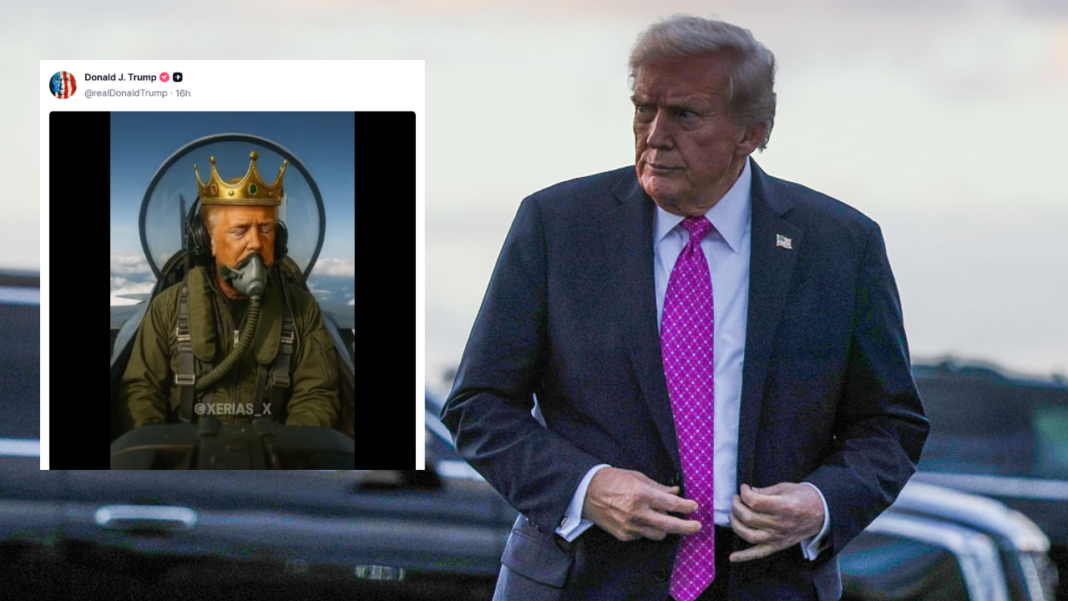The Controversy Surrounding Trump’s AI-Generated Video
In a striking display that has sparked intense debate, U.S. President Donald Trump recently shared an AI-generated video on his social media platform, Truth Social. The crude depiction shows the former president, adorned with a crown, supposedly dumping feces on protesters opposing his administration. This unsettling act coincided with nationwide demonstrations against Trump, specifically the “No Kings” protests held in major cities across the country.
The Context of the “No Kings” Protests
On the same day Trump posted the video, millions participated in the “No Kings” demonstrations, organized by various social justice groups, including the ACLU and MoveOn. These protests were a reaction to what many perceive as Trump’s authoritarian governance style and the ongoing challenges highlighted by his administration. Organizers reported that approximately 7 million people turned out for over 2,700 events across all 50 states. Notably, major media outlets, including CNN, noted that these protests were largely peaceful, with minimal police incidents or arrests.
A Disturbing Video
The 15-second video features an animated Trump piloting a fighter jet emblazoned with “King Trump.” In a clearly provocative move, it depicts AI-generated figures of protesters in New York’s Times Square being doused with what appears to be feces. Remarkably, Trump shared this video without any accompanying commentary, leaving it open to interpretation. The implications of such a representation, especially during a time of significant civil unrest, have left many unsettled.
Public Reaction and Outrage
The response to Trump’s video has been swift and vehement. Journalist Joy Reid weighed in, expressing her disbelief and disgust. In a passionate critique, she remarked, “He literally believes that the American people are a pot to s–t in, and he has no respect for the American people.” Reid went on to characterize Trump’s action as “nasty and disgusting,” drawing parallels to the behavior exhibited during the January 6 insurrection, where feces were notably smeared within the Capitol.
Human rights attorney and Sirius XM host Qasim Rashid echoed Reid’s sentiments, labeling Trump as a reflection of contemporary conservatism rather than a deviation from it. Rashid pointed out the troubling normalization of such imagery and behavior within political discourse.
Underlying Issues Leading to Protests
The backdrop of these protests includes a rising tide of opposition to various actions taken by Trump. Controversial policies, including mass immigration raids and the deployment of military troops in predominantly Black and Brown communities, have sparked alarms among activists and citizens alike. Furthermore, legal actions against political opponents, such as New York Attorney General Letitia James, only add fuel to the fire of dissent.
Additionally, there are concerns about mass layoffs within the federal workforce and significant cuts to essential social programs like Medicaid and SNAP. These cuts have a direct impact on vulnerable communities already struggling in the face of economic challenges.
The Need for Continued Activism
In light of these events, activist Angela Angel remarked on the importance of unity in facing systemic issues. Emphasizing that the current political climate should not be accepted as “normal,” Angel called for collective action. She described the administration’s practices as teetering on the edge of fascism, a term she used with caution yet conviction.
Her comments resonate with the growing sentiment among those participating in the protests: a desire to reclaim power and demand accountability from a government that seems increasingly insulated from public opinion. Angel stressed the necessity of gathering to remind one another of their rights and the power they hold to enact change.
Conclusion
The uproar surrounding Trump’s AI-generated video highlights a broader conversation about the boundaries of political discourse and the role of social media in shaping public opinion. As the debate continues, the intersection of art, technology, and activism remains a compelling aspect of contemporary American politics.



